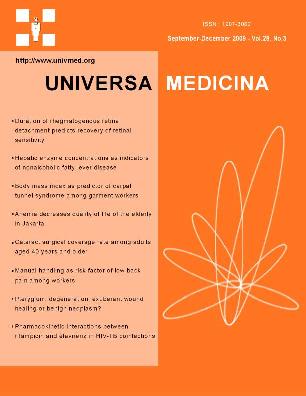Pharmacokinetic interactions between rifampicin and efavirenz in HIV-TB coinfections
Main Article Content
Abstract
Article Details
Issue
Section
The journal allows the authors to hold the copyright without restrictions and allow the authors to retain publishing rights without restrictions.
How to Cite
References
Manuhutu EJ. Peran riset dalam bidang tuberkulosis paru untuk menunjang pembangunan nasional. Pidato Pengukuhan Guru Besar FK UI, April 2006.
Clain KP, Anekthananon T, Burapat C, Akkslip S, Mankhatitham W, Srinak C, et al. Causes of death in HIV-infected persons who have tuberculosis. Thailand Emerg Infect Dis 2009;15:258-64.
Jindani A, Nunn AJ, Enarson DA. Two 8-month regimens of chemotherapy for treatment of newly diagnosed pulmonary tuberculosis: international multicenter randomized trial. Lancet 2004;364: 1244-51.
World Health Organization. Antiretroviral Therapy for HIV Infection in Adults and Adolescents: recommendations for a public health approach. Geneva, Switzerland: World Health Organization; 2006 revision. Available at: http://www.who.int/hiv/pub/guidelines/artadultsguidelines.pdf. Accessed May 19, 2009.
Center for Disease Control and Prevention. Managing drug interactions in the treatment of HIV-related tuberculosis [online].2007. Available at: http://www.cdc.gov/tb/TB_HIV_Drugs/default. htm. Accessed February 18, 2009.
Friedland G, Khoo S, Jack C, Lallo U. Administration of efavirenz (600 mg/day) with rifampicin results in highly variable level but excellent clinical outcomes in patients treated for tuberculosis and HIV. Antimicrob Agents Chemother 2006;58:1299-302.
Idemyor V. HIV and tuberculosis coinfection: inextricably linked liaison. J Natt Med Assoc 2007; 99:1414-9.
Burzynski JN, Schluger NW, Garay SM. Tuberculosis and the human immunodeficiency virus infection. In: Rom WN, Garay SM, editors. Tuberculosis. 2nd ed. Philadelphia: Lippincott Williams & Wilkin;2004.p.663-8.
DHHS panel of antiretroviral guidelines for adults and adolescent. Guidelines for the use of antiretroviral agents in HIV-1 infected adults and adolescents. Department of Health and Human Services. Available at: http://www.aidsinfo.nih. gov/ContentFiles/AdultsandAdolescentGL.pdf. Accessed June 25, 2009.
Drug interaction. In: Grahame-Smith DG, Aronson JK, editors. Oxford Textbook of Clinical Pharmacology and Drug Therapy. 3rd ed. New York: Oxford University Press;2002.p.104-17.
Piscitelli SC, Gallicano KD. Interaction among drugs for HIV and opportunistic infections. N Engl J Med 2001;344:984-96.
Gonzalez FJ, Tukey RH. Drug metabolism. In: Brunton LL, Lazo JS, Parker KL, editors. Goodman & Gilman’s. The Pharmacological Basis of Therapeutics. 11th ed. New York: McGraw-Hill; 2006.p.71-91.
Handschin C, Meyer UA. Induction of drug metabolism: the role of nuclear receptors. Pharmacol Rev 2003;55:649-73.
Chen J, Raymond K. Roles of rifampicin in drug-drug interactions: underlying molecular mechanisms involving the nuclear pregnane X receptor. Ann Clin Microbiol Antimicrob 2006;5:1-11.
Wilson TM, Kliewer SA. PXR, CAR, and drug metabolism. Nat Rev Drug Discov 2002;1:259-66.
Kliewer SA, Goodwin B, Willson TM. The nuclear receptor pregnane X receptor: a key regulator of xenobiotic metabolism. Endocr Rev 2002:23:687-702.
Chen J, Raymond K. Roles of rifampicin in drug-drug interactions: underlying molecular mechanisms involving the nuclear pregnane X receptor. Ann Clin Microbiol Antimicrob 2006;5:1-11.
Mcllleron H, Meintjes G, Burman WJ, Maartens G. Complications of antiretroviral therapy in patients with tuberculosis: drug interactions, toxicity, and immune reconstitution inflammatory syndrome. J Infect Dis 2007;196:S63-S75.
Petri WA. Chemotherapy of tuberculosis, Mycobacterium avium complex disease, and Leprosy. In: Brunton LL, Lazo JS, Parker KL, editors. Goodman & Gilman’s. The Pharmacological Basis of Therapeutics. 11th ed. New York: McGraw-Hill;2006.p.1207-10.
Vernon AA. Rifamycin antibiotics, with a focus on newer agents. In: Rom WN, Garay SM, editors. Tuberculosis. 2nd ed. Philadelphia: Lippincott Williams & Wilkin;2004.p.760-70.
Flexner C. Antiretroviral agents and treatment of HIV infection. In: Brunton LL, Lazo JS, Parker KL, editors. Goodman & Gilman’s The Pharmacological Basis of Therapeutics, 11th ed. United State of America: McGraw-Hill;2006.p.1292-6.
Ward BA, Gorski JC, Jones DR, Hall SD, Flockhart DA, Desta Z. The cytochrome P450 2B6 (CYP2B6) is the main catalyst of efavirenz primary and secondary metabolism: implication for HIV/AIDS therapy and utility of efavirenz as a substrate marker of CYP2B6 catalytic activity. Pharmacol Exp Ther 2003;306:287-300.
Lopez-Cortez LF, Ruiz-Valderas R, Viciana P, Alarcon-Gonzalez A, Gomez-Mateos J, Leon-Jimenez E, et al. Pharmacokinetic interactions between efavirenz and rifampicin in HIV-infected patients with tuberculosis. Clin Pharmacokinet 2002;41:681-90.
Manosuthi W, Sungkanuparph S, Thakkinstian A, Vibhagool A, Kiertiburanakul S, Rattanasiri S, et al. Efavirenz levels and 24-weeks efficacy in HIV-infected patients with tuberculosis receiving highly active antiretroviral therapy and rifampicin. AIDS 2005;19:1481-6.
Manosuthi W, Kiertiburanakul S, Sungkanuparph S, Ruxrungtham K, Vibhagool A, Rattanasiri S, et al. Efavirenz 600 mg/day versus efavirenz 800 mg/day in HIV-infected patients with tuberculosis receiving rifampicin: 48 weeks results. AIDS 2006; 20:131-2.
Marzolini C, Talenti A, Decostered LA, Greub G, Biollaz J, Buclin T. Efavirenz plasma level can predict treatment failure and central nervous system side effect in HIV-1 infected patients. AIDS 2001; 15:71-5.
Brennan-Bonson P, Lyus R, Harrison T, Pakianathan M, Macallan D. Pharmacokinetic interactions between efavirenz and rifampicin in the treatment of HIV and tuberculosis: one size does not fit all. AIDS 2005;19:1541-3.
Haas DW, Ribaudo HJ, Kim RB, Tierney C, Wilkinson GR, Gulick RM, et al. Pharmacogenetics of efavirenz and central nervous system side effects: an Adults AIDS Clinical Trial Group Study. AIDS 2004;18:2391-400.
Gatanaga H, Hayashida T, Tsuchiya K. Successful efavirenz dose reduction in HIV type-1-infected individuals with cytochrome P450 2B6*6 and *26. Clin Infect Dis 2007;45:1230-7.
Burger D, van der Heiden I, la Porte C, van der Ende M, Groeneveld P, Richter PK, et al. Interpatient variability in the pharmacokinetics of the HIV non-nucleoside reverse transcriptase inhibitor efavirenz: the effect of gender, race, and CYP2B6 polymorphism. Br J Clin Pharmacol 2005; 61:148-54.
Pozniak AL, Collins S, Coyne KM, Freedman AR, Johnson MA, Lipman MCI, et al. British HIV Association guidelines for the treatment of TB/HIV co-infection (2009). Available at: http://www.bhiva. org/cms1223707.asp. Accessed September 11, 2009.
DiGiacinto JL, Chan-Tack KM, Robertson SM, Reynolds KS, Struble KA. Are literature references sufficient for dose recomendations? An FDA case study of efavirenz and rifampin. J Clin Pharmacol 2008;48:519-23.


